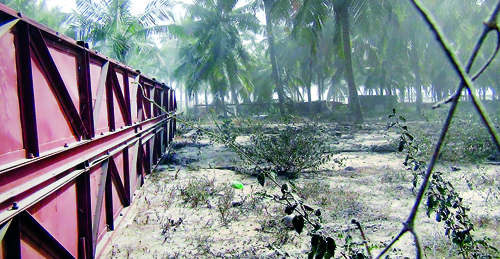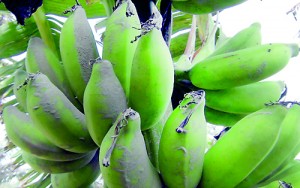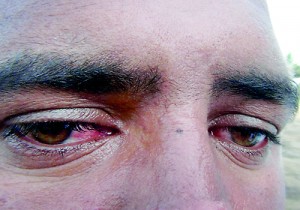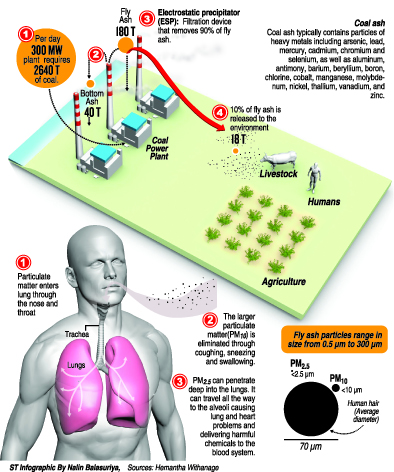News
Monsoon blows foul emissions landward, covering crops, houses with ash
Nilmini, 27, wraps her arms around her swollen belly and fears for the child within as clouds of ash from the Norochcholai plant thicken the air like mist, settles thickly on crops and is triggering respiratory illnesses, rashes and eye problems.

Coconut trees and bananas covered in ash
The Sunday Times learns that area medical officers are being obstructed in attempts to visit the coal-fired power plant and check the hazardous ash emissions.
Every day Nilmini, who lives in Illanthadiya, bordering the power plant, has to wipe a new layer of ash off the furniture and other fittings in her home.
Another resident, Saman Susil Fernando, whose eyes are reddened, says those like him who work outside, exposed to the ash-filled air, suffer severe discomfort in the eyes.
There are more than 200 families in the Illanthadiya area.
The area’s small cash crops – vegetables, fruit, chillies, onions and tobacco – are suffering, laments farmer Leslie Ranjith. He said the strong monsoonal winds from the ocean, result in the ash blowing to the land, and there are moments when thick ash fills the air like  mist.
mist.
“People in the area are helpless as authorities have not responded to their pleas nor have arrived in the area and conduct tests. Many people in the area have coughs, asthma and wheezing,” he said.
Residents say that from end of April, strong winds blow from the ocean towards the land for six months, sometimes longer. This is blowing the ash towards human habitation.
“If Stage One of the project (300 megawatt) and Stage Two, with another 300 MW are emitting this much ash, the third stage, which is in the process of being completed will cause even greater trouble to the local people,” one resident said.
Hemantha Vithanage, Executive Director, Centre for Environmental Justice said fly ash, ash produced from burning of powdered coal, has covered the area and severely affecting crops in the area. Added to that is blow-off from the heaps of ground ash.

Discomfort in the eyes: Saman Susil Fernando
Fly ash, which is scooped up by filtration equipment during the combustion of coal, is composed of tiny particles of silica and, depending on the type of coal being burned, can contain amounts of arsenic, lead, mercury, chromium, dioxides and other substances. Ground ash is removed from the bottom of the furnace.
A 300MW power plant uses 2,640 tons of coal daily that can produce result in about 180 tons of fly ash and 40 tons of ground ash. About 90 per cent of the fly ash

Nilmini afraid for her unborn
captured by an electrostatic precipitator, a filtration device used in chimneys to remove fine particles like dust and smoke, while 10 per cent is released to the air as fly ash. Ground ash needs proper storage.
Industrial action that went on for weeks until this month at the Holcim cement plant which takes and uses ash from the Norochocolai plant, has resulted in heaps of ash accumulating at the coal plant being blown by the monsoon winds towards settlements.
“The current mass dispersal of both kinds of ash is a clear indication that pollution mitigation strategies have not been followed. We are studying the situation before taking legal action,” Mr. Vithanage said.
“We have received complaints from organic farm owners and farmers,” Mr Vithanage said. “The ash will also affect local salt production.
“We feared this threat many years ago and have been complaining. Fly ash can be blown long distances from the south-west monsoon winds.”
When contacted, Central Environment Authority (CEA) top officials and officers in the pollution control unit stated that environmental concerns from the Norochcholai power plant were handled by the Provincial Environmental Authority of the North Western Province.
Under the Provincial Environmental Statute of 1990, the CEA is in charge of the environmental quality of industrial discharges such as smoke, noise, waste-water, odour etc. and has powers to issue Environmental Protection Licences (EPL) Environmental Site Clearance Certificates (ESCC) and carry out Environmental Impact Assessments.
Attempts made to contact CEA Director Dr. Saman Senanayake failed. A top CEA official who did not wish to be named said the authority would inform its provincial counterpart to look into the ash emission and take action.
Professor Ajith de Alwis of Moratuwa University’s Department of Chemical and Process Engineering, said though electrostatic precipitators (ESP) were the best way to minimise pollution in coal power plants, its performance depends on the nature of the coal used and how efficiently it is being used.
“Coal may carry certain amount of toxicity depending on the heavy metals that may be present. Fly ash is used in the construction industry, especially in cement production. However, there is a threat to human health as inhaling coal dust or ash can result in respiratory illnesses. It is definitely an environment pollutant and hazardous waste material. Therefore care in handling is important,” said Professor de Alwis.
Ceylon Electricity Board Deputy General Manager Jayantha Saram acknowledged that the protest at the Holcim cement work had prevented the collection of Norochcholai ash for several weeks but said all measures had been taken to control emissions.
Pictures and additional reporting by Puttalam Correspondent Hiran
Priyankara Jayasinghe

